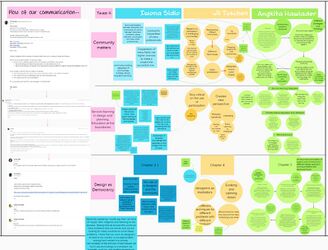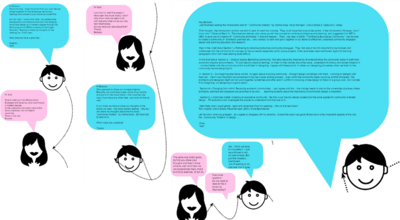LED2LEAP 2021 - Nürtingen Team 5: Difference between revisions
| Line 157: | Line 157: | ||
== Reflect on Your Story of Visioning == | == Reflect on Your Story of Visioning == | ||
* | *The steps to formulating goals include, community mapping, stakeholder identification , landscape analysis and then engaging with the community . Basic questions to keep in mind when discussing design project , its goals and visions with the community would be : | ||
1. How does positive change emerge? | |||
2.How do we find coherent solutions? | |||
3.What promotes innovative planning? | |||
The characteristics of a good vision would be : | |||
1.Focused ,short, simple and easy to understand even to a 9 year old. | |||
2.Connects with the community. (Vocabulary of the place becomes the language of the design ,vision & goal setting) | |||
3.Should be worth sharing ; needs to be linked to the positive change in the community. | |||
<gallery caption=" " widths="200px" heights="150px" perrow="5"> | <gallery caption=" " widths="200px" heights="150px" perrow="5"> | ||
| Line 164: | Line 175: | ||
File:PlaceholderImage_12.jpg|''insert text here'' | File:PlaceholderImage_12.jpg|''insert text here'' | ||
</gallery> | </gallery> | ||
= Phase D: Collaborative Design, Transformation and Planning = | = Phase D: Collaborative Design, Transformation and Planning = | ||
Revision as of 08:42, 8 June 2021
>>>back to working groups overview
For help with editing this Wiki page use this link.
For assignments and key readings use this link.
| Area | Steinach River Bank | |
| Place | Nürtingen | |
| Country | Germany | |
| Topics | Making Steinach River accessible to the community | |
| Author(s) | Angkita Hawlader, Yasif Alavi, Christian Barrera, Maximilian Stauch | |

| ||
Landscape Democracy Rationale
- insert text here
Location and Scope
- insert text here
Phase A: Mapping Your Community
Welcome to Your Community and Their Landscape
Groups of Actors and Stakeholders in Your Community
- insert text here
Relationships Between Your Actors and Groups
- insert text here
Summary of Your Learnings from the Transnational Discussion Panel
- insert text here
Theory Reflection
- insert text here
Reflection on theory 'Things that went well':We found the theory of working in PAR spiral very helpful where each step involves assumptions, experimentation, reflection and revised assumption -Starting each process with assumption helped us in moving forward with the mapping exercises since three members from our team are not in Nurtingen - Helped us in being creative in imagining what the people want. -Information about nurtingen was available online as well. Things that were difficult -Online research / working in group online was tiring. Not meeting in person with groups members is different and is taking more time during discussions. -Communicating and talking to people in person and over phone/ Internet is very different
References
- insert text here
Phase B: Democratic Landscape Analysis and Assessment
Angkita Hawlader , Iwona Sidlo and Jil Tuschen Correspondence
Maximilian Stauch and Lena Bartens Correspondence
Yasif Alavi and Barbara Bozsik Correspondence
- ''insert text here''
Your Name and Partner's Name Correspondence
- ''insert text here''
Your Name and Partner's Name Correspondence
- ''insert text here''
Phase C: Collaborative Visioning and Goal Setting
The Scene in Your Story of Visioning
- insert text here
The Actors in Your Story of Visioning
- insert text here
The Story of Visioning
- insert text here
Reflect on Your Story of Visioning
- The steps to formulating goals include, community mapping, stakeholder identification , landscape analysis and then engaging with the community . Basic questions to keep in mind when discussing design project , its goals and visions with the community would be :
1. How does positive change emerge? 2.How do we find coherent solutions? 3.What promotes innovative planning?
The characteristics of a good vision would be : 1.Focused ,short, simple and easy to understand even to a 9 year old. 2.Connects with the community. (Vocabulary of the place becomes the language of the design ,vision & goal setting) 3.Should be worth sharing ; needs to be linked to the positive change in the community.
Phase D: Collaborative Design, Transformation and Planning
Your Prototyping Action
- insert text here
The Evolution of Your Prototyping Action
- insert text here
The Plan Behind Your Prototyping Action
- insert text here
The Realization of Your Prototyping Action
- insert text here
Reflect on Your Prototyping Action
- insert text here
Phase E: Collaborative Evaluation and Future Agendas
Collaborative Evaluation and Landscape Democracy Reflection
- insert text here
The Actors in your Collaborative Evaluation
- insert text here
Reflection on the Online Seminar
- insert text here
Reflection on the Living Lab Process
- insert text here
Your Living Lab Code of Conduct
- insert text here
Process Reflection
- insert text here































